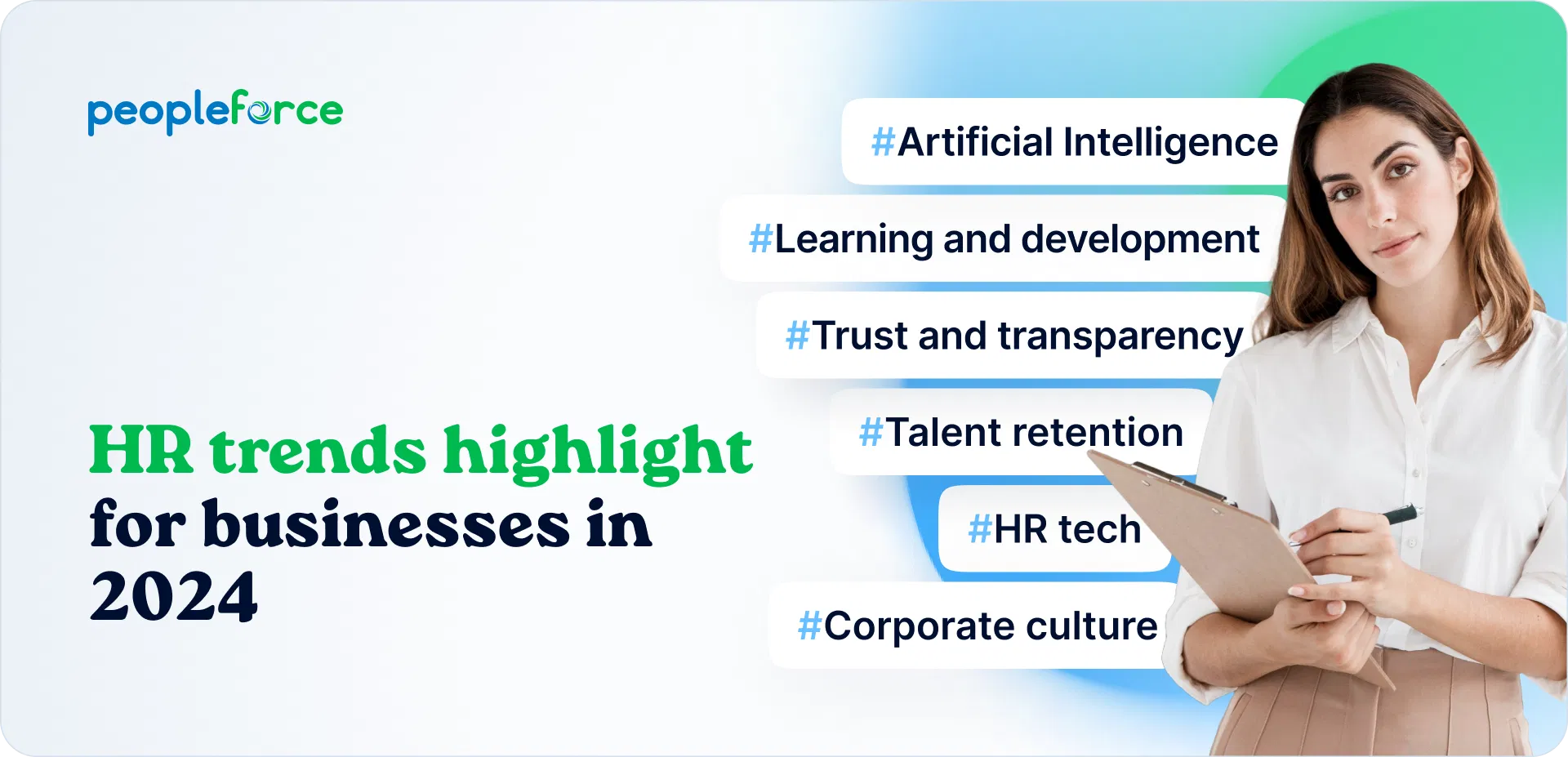
HR trends highlight for businesses in 2024
Now is just the time when goals for the upcoming year are already set, but they are just starting to take shape and understanding how to achieve them. This also applies to the HR direction in the company, as we all agreed long ago – there is no business success without talents. So let's start this year right, reviewing all the analytical HR reports with forecasts and trends for 2024.
We didn't waste time and looked at all the available information for you to immediately get a short summary of what's happening and what to pay extra attention to in organizing processes within the team.
Sources
We've reviewed several prominent sources of information on HR trends, including reports from Gartner, McLean&Co, Deloitte's Global Human Capital Trends for 2024, Forbes' coverage of the eight major HR trends in 2024, and others.
What will 2024 be like for the HR industry?
All research and reports on HR trends touch upon similar topics in one way or another. For a general understanding, let's look at the summary table – we've included everything here that an HR specialist should consider this year to be ahead.
Trend | What’s included | Meaning |
|---|---|---|
Artificial Intelligence in HR | AI technology helps employees at all levels of their work experience by replacing functional and technical skills. However, they also provoke an increase in workforce stress. | The AI trend cannot be considered in isolation from both the benefits and the harm it brings. HR specialists should focus on improving employees' lives with AI without increasing the risk of burnout. |
HR tech | Technologies include HRM, HRIS, HR platforms, ATS, time and attendance tracking systems, benefits management systems, etc. | Technologies that can improve employee well-being, lighten their workload, optimize routines, save time, and make them happier and more focused on their own goals. |
Talents’ attraction and employee retention | Building a full-cycle employee retention strategy – from talent sourcing and attraction to opportunities for employee engagement and development within the company. | This includes a wide range of tasks and functions that go down to the question, 'What do we need to do to make people interested in working for us?' |
Trust and transparency | The desire of companies to be open and supportive AND their actual plans to do so. | A significant gap arises between what companies want to do for their employees and what is already planned and executed. This gap is called the 'trust and transparency paradox'. |
Work with different generations | First and foremost, the strategy for working with Generation Z. | Again, there is a gap between generations and trends for overcoming the management crisis, including change management practices. |
Corporate culture | Flexible working, office experience for collaboration among employees, building healthy work-life balance, and preventing strikes due to poor or unethical working conditions. | Various elements of HR and business functions help build a company culture of productivity, environmental friendliness, inclusivity, and openness in the organization. |
Human sustainability | Developing internal strategies and metrics to achieve the overall external strategy for sustainable human development. | Nurturing employees on a global scale, instilling values, and creating a common workforce of engaged and satisfied professionals worldwide. |
Learning and development | Upskilling and reskilling, leadership and management development, career management, soft skills (emotional intelligence etc.). | There is a strong focus on development within management and leadership to prevent a gap between the leader and the team, as well as attention to internal employee career development instead of external hiring. |
How do you interpret and use these HR trends?
Have you noticed that trends are now highly people-oriented? The era of achieving anything by any means has thankfully passed. Let's consider any of the listed trends. We notice that the main focus is on people and employee wellbeing, building and nurturing strong connections and relationships with each individual for the team's overall improvement.
We invite you to notice trends and see how they can be applied to the company. Next, we will detail the use cases for each trend, taking into account the HR tools that will be useful for your human resource management planning.
1. AI in HR – trend or threat?
Gartner's research shows that 76% of HR leaders agree with the belief: if they don't implement AI tools in the next 12-24 months, their companies will experience declines in organizational processes.
The explanation for such a global AI boom may not only be the need for a fast, versatile, and long-lasting assistant for everyday tasks but also very real figures – for example, Statista's research tells us that implementing AI in operations brings up a 10% increase in revenue, and 46% of American companies save between $25,000 to $70,000 using ChatGPT.
Such an advantage makes the AI sphere the number 1 trend and one of the world's fastest-growing and most expensive technological industries. In 2023, it is estimated to be $142.3 billion.
But there’s more. Here are some use cases to prove AI is one of the most change-encouraging leverages for the workforce:
- Westpac allows employees to code with AI, boosting productivity by 46% without sacrificing quality.
- Zapata Computing, BMW, and MIT use generative AI inspired by quantum tech to enhance automotive production efficiency.
- AI growth demands creative thinking. Shionogi & Co. offered a four-day workweek to promote digital upskilling and creativity among employees, resulting in beneficial outcomes.
The flip side of the trend is not so bright. Everyone talks about whether AI can potentially replace employees and destroy jobs. But some aspects are not often discussed:
- The need to upskill at least 20% of corporate employees
- Increased focus on technical skills
- Shift towards internal hiring and rehiring
- AI-driven talent sourcing.
All of this will fundamentally change the talent acquisition process, which is the starting point of an employee experience. The positive aspect is that attention will be given to those individuals who possess practical and technical skills - something they can offer that machines cannot. However, there is a concern that initially, companies will focus on hiring seniors, not juniors and even middles etc.

Solution: Choose to focus on people
Don't forget about people. Ironically, all further trends to be discussed are about talents and their needs amid such technological breakthroughs.
Deloitte highlights skills that AI can't replace, signalling a new era emphasizing soft skills. These skills, crucial for teamwork and personal growth, include:
- Curiosity: The drive for knowledge, fostering better communication, teamwork, and innovation while reducing conflicts and errors in decision-making.
- Informed agility: The ability to adapt quickly to new situations by continuously gathering, filtering, and integrating information.
- Resilience: The determination to persevere through challenges and rapid changes.
- Connected teaming: Effective collaboration across boundaries, fostering empathy and leveraging diverse strengths, including human-machine collaboration.
- Divergent thinking: The capacity to think creatively and generate new ideas by finding connections between seemingly unrelated concepts, promoting innovation and inclusivity.
- Social and emotional intelligence: Recognizing, managing, and expressing emotions empathetically, fostering personal and organizational values and a culture of growth.
AI may or may not be applicable to organizations, depending on their goals and capabilities. However, the trend towards HR tech is distinct and cannot be ignored, even by SMEs.
2. HR tech: a must-have
AI is only becoming more popular, but HR tech has already become a big deal in the past few years. It's super important now as we try to balance people and tech. Without HR solutions, we'd struggle to keep up with all the scaling and growth. However, many companies are slow to update new HR tools.
About 56% of HR pros say the tech they use doesn't match where they want to go with digitalization. That's because HR management doesn't yet understand which technology to choose. The HR sphere isn't ready for AI due to economic reasons, but companies are pushing for it—if not AI, then what to choose to make processes easier?
Solution: Choose HR platforms for better employee experience
The best choice here is to pick an HR platform that does many things right from the start. It should be able to grow with the company and change as needed. This kind of HR technology can help with:
- Talent management, acquisition and retention
- Full-cycle recruiting and hiring
- Getting new employees ready to start, helping them settle in, and wrapping things up when they leave
- Sharing information and building transparent communication
- Self-service
- Performance evaluation and feedback
- Setting goals and helping employees grow professionally
- HR metrics and analytics
- Supporting the employee’s experience
One big advantage of an HR platform, especially with recent trends, is that it won't cause additional stress. Instead, it'll help with routines so there's more time and energy for leaders'/team growth and learning.
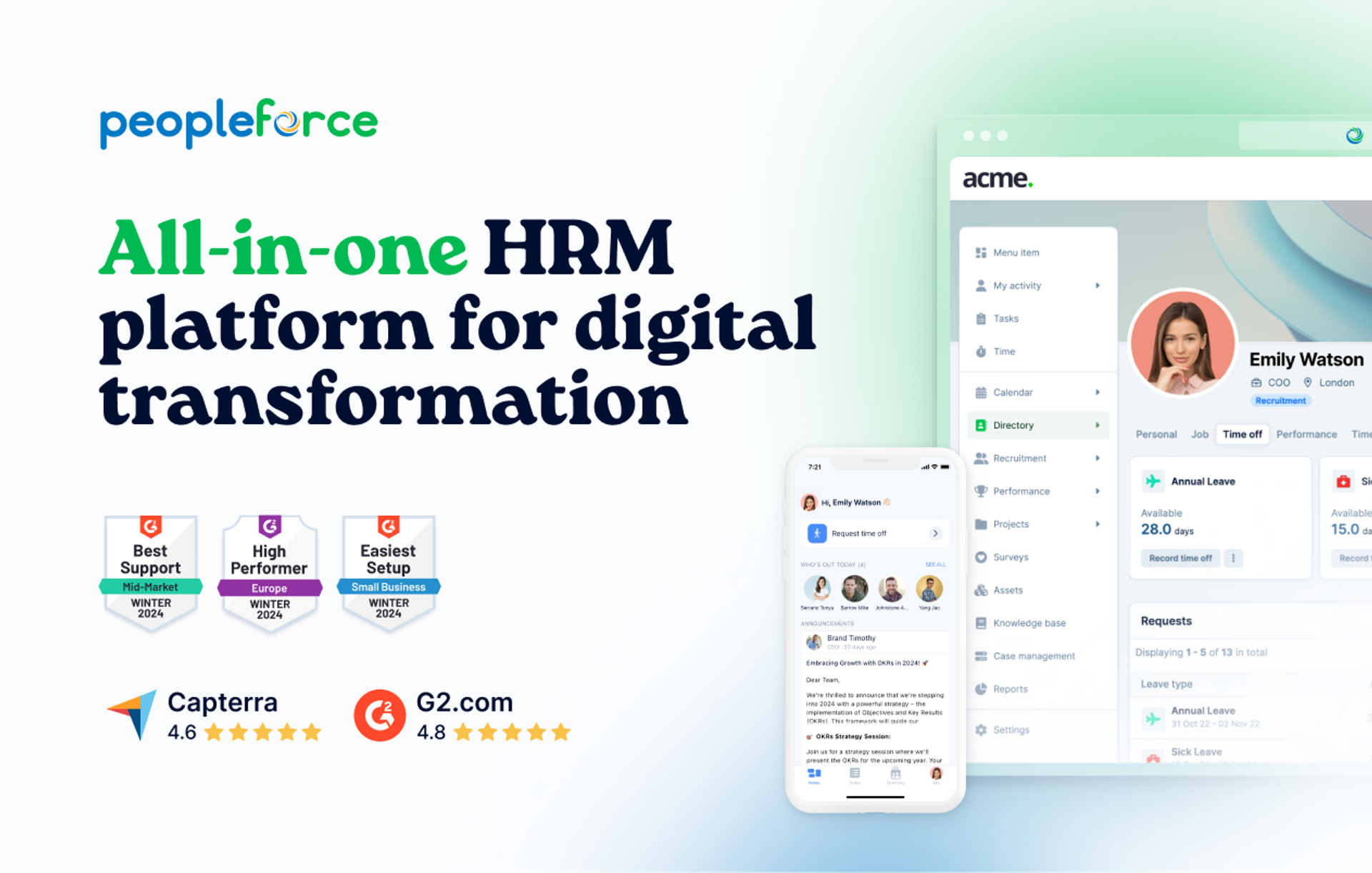
3. Prioritizing talent retention
The labour market is changing at lightning speed, as the role of HR management and recruiting in companies.
External hiring is becoming a luxury; it is sad but true. Now, HR must think more about how to attract and retain employees, grow, and, if necessary, reskill them. It's not just about competitive pay – it's also about job satisfaction, good work-life balance, employee engagement, etc. People want to see themselves in a company that creates a culture different from others, a culture of inclusivity, openness, and stability.
This also applies to the work cycle. Gartner's research tells us that traditional career maps don't work. 89% of HR leaders say that most employees' career paths are unclear. How do we change the environment within the company?
Solution:
As stated in the insights, here are 4 steps to achieving stability within the team:
- Reset expectations
- Rebuild pipeline (processes)
- Rewire habits
- Remove process hurdles
They can be applied to any aspect of the work cycle. These steps take us from rethinking the job position to optimizing HR processes (hello again, HR solutions!). They are also adaptable to the concept of sustainable corporate culture.

4. How to build a sustainable corporate culture
Let's touch on two intertwining HR trends: building culture and human sustainability. While the first is more or less understood, the second needs explanation.
In short, the concept of sustainability in HR means not creating value in material outcomes but instead creating value for people.
Deloitte says companies try to cherish internal connections and intellectual assets, but this is short-term thinking. Leaders still prioritize financial and material legacy rather than talent. They should focus on employee satisfaction instead.
The concept of human sustainability is global; it's a call for all companies worldwide to develop people to achieve a smarter workforce at all levels.
Meanwhile, the funnel looks like this: 76% of companies understand the importance of sustainable development, but only 46% of them are taking action in this direction, and only 10% of them succeed in creating a people-oriented culture.
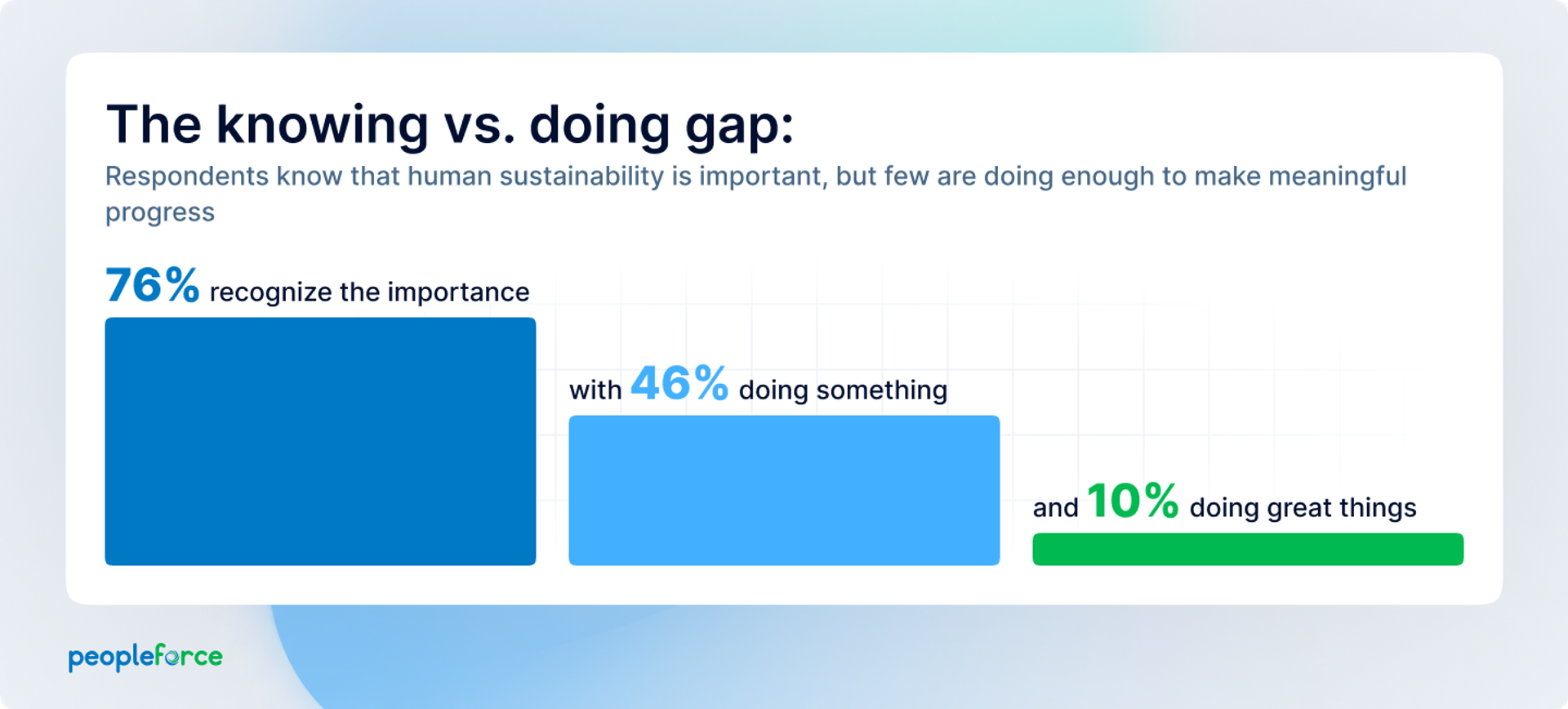
Solution: Build the microculture
The task for the next-generation HR leaders will be to rethink whether the culture in their organization embodies all elements of sustainability, such as trust, transparency and more.
But since everyone will be trying to do this, it's important to encourage a microculture within the company to be different and attractive as a brand. This means letting employees, small groups and teams grow and learn at their own speed, listening to what they want, sharing ideas between different departments or locations, and supporting new and different ways of doing things.
What tools can help with this:
- Continuous feedback. Always maintain communication with employees to cultivate positive internal relationships.
- Case management. Quickly resolving any issue from anywhere in the world is key to team success.
- Flexible schedules and attendance. You should show people right from the start that they will be able to adjust work to fit their needs.
- Safe space for expressing thoughts or issues. Provide the team with a way for whistleblowing to give them the right to speak out.
5. Why does the trust paradox arise
This is where the so-called transparency and trust paradox arises when creating a truly open culture within the team. Let's look at the official data from Deloitte:
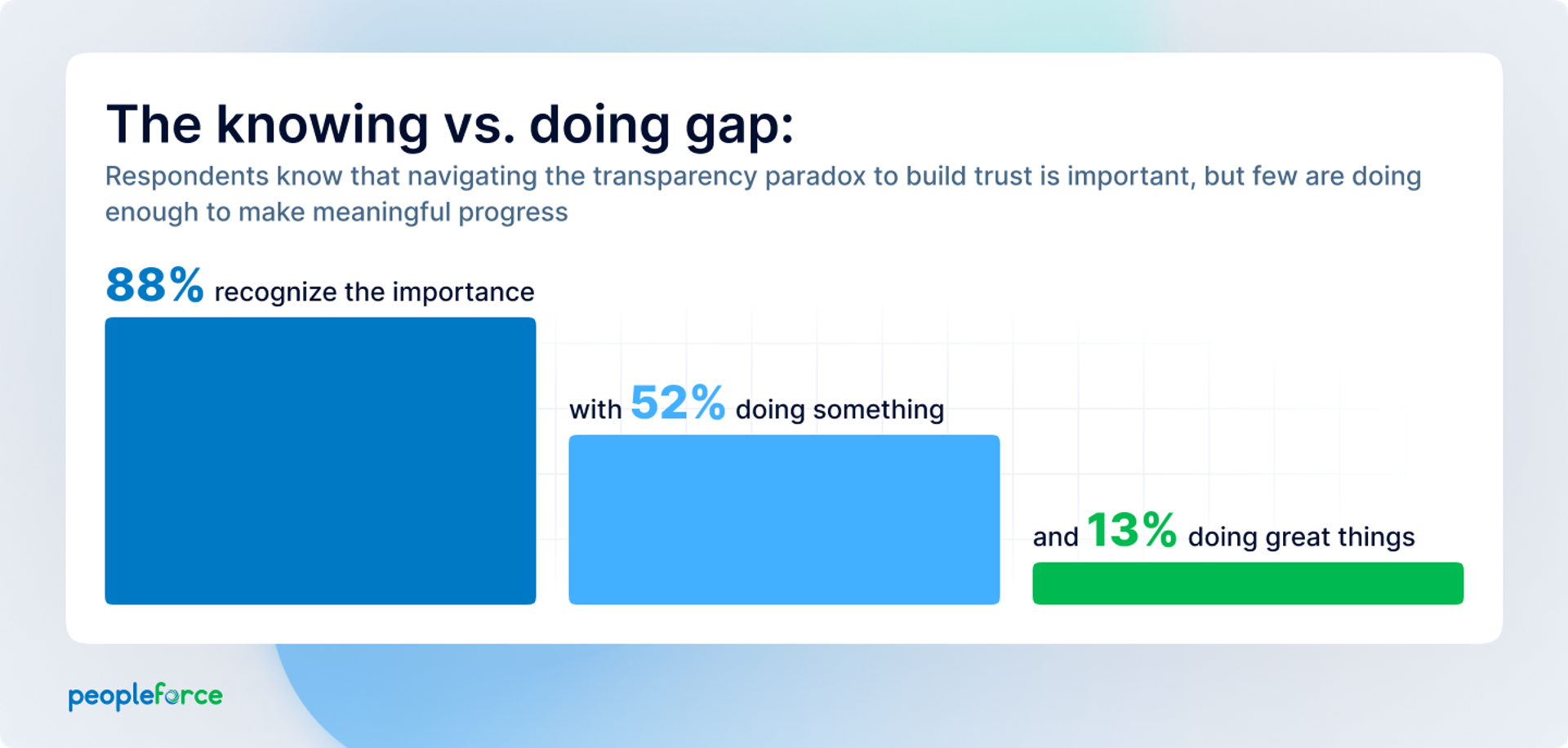
So, there's such a huge gap between what the organization's leadership understands about transparent communication – and what it actually does. 88% and 13%. It's hard to believe.
If you happen to be an HR person from a company with such statistics, congratulations, you're in the right place. We have a solution for this HR trend for you.
Solution: Harness 1:1s for recurring communication
In a company where 1:1s are not set u, and employees are not getting attention from leaders, trust and transparency will be inevitable issues. To join the happy 13% who genuinely want to improve their company, use the 1:1 functionality to have regular meetings with employees and encourage them to speak up.
6. Learning to grow to change the company’s flow
We mentioned earlier that skills are now highly valued, and changes in all aspects of work are unavoidable. Now, the question arises: how do we learn to adapt to these changes and, more importantly, how do we train our team, including leadership?
73% of HR leaders have confirmed that the leaders and managers in their organizations lack the necessary skills to lead change. 50% of employees are not confident in their manager’s ability to lead their team to success in the next two years.
So, the question of upskilling and reskilling needs to be addressed even for company leaders who fail to inspire their teams. This brings us back to the issue of the gap between managers and employees, as well as to the trends towards people-centric approaches. One of the people-oriented skills is emotional intelligence.

Solution: Develop emotional intelligence
75% of Fortune 500 companies are already using emotional intelligence. This trend never goes away and reminds us each year. Leaders can't change in 2024 if they don't open up to emotional growth. To understand your team and adapt to human trends, you need to change how you work—and having high emotional intelligence is crucial.
Here are some HR tools that will help you understand your team better and support its growth and development:
- Surveys and feedback to know how engaged your team is
- Workflows to make processes easier and transparent for everyone
- HR analytics and reporting for making decisions based on data, not just personal opinions
Summary
In 2024, HR is all about putting people first. Trust and transparency are essential. Another crucial aspect is valuing skills above all else. HRs need tools and platforms to tackle these trends that facilitate feedback, streamline flows, and provide data-driven insights. This ensures the company stays aligned with its goals and fosters a supportive, open workplace culture.
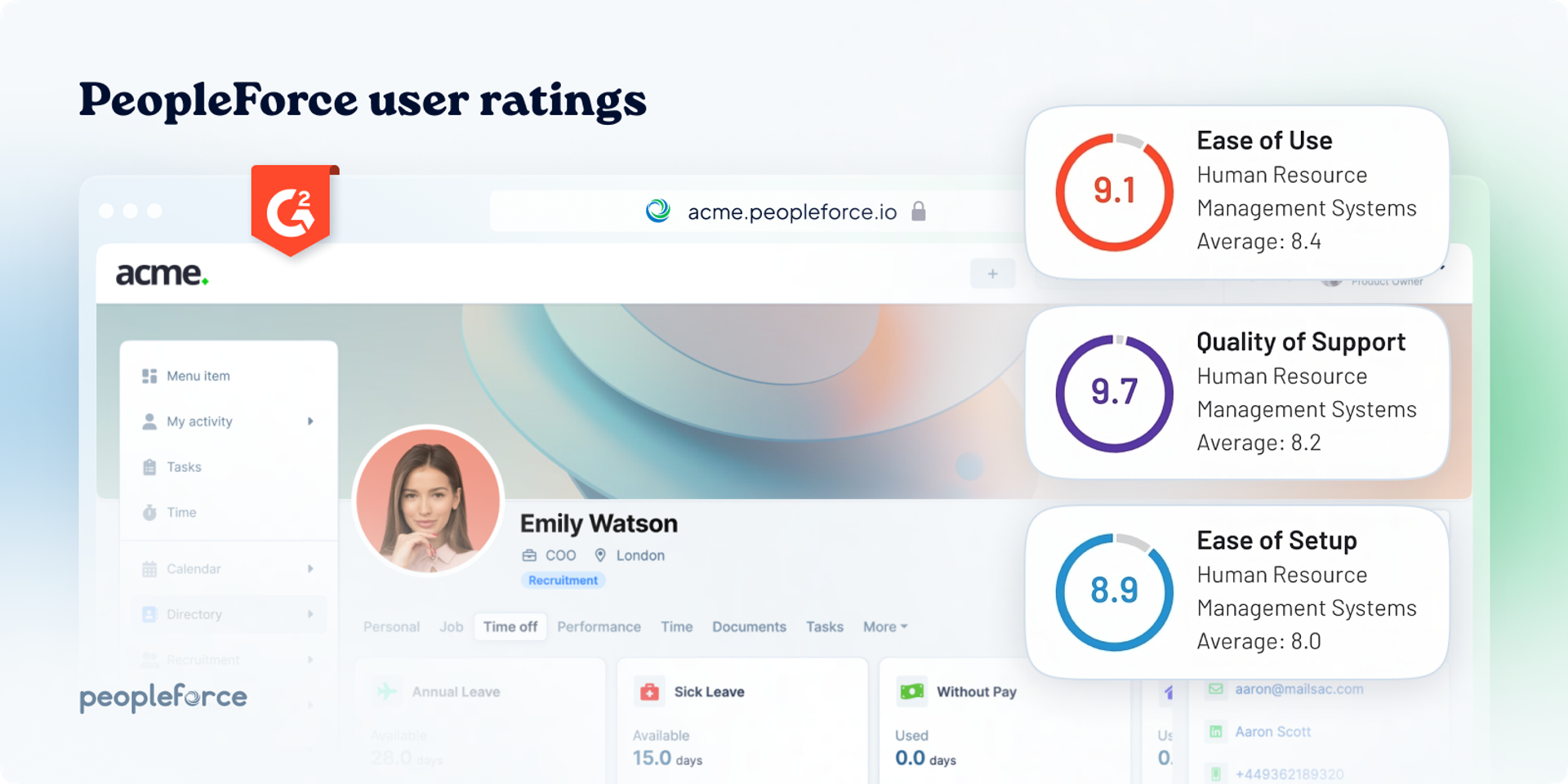
If you're a modern HR specialist or manager, we recommend looking at PeopleForce. We will help you navigate all the mentioned trends and understand how to manage your people stress-free and improve them. We're ready to discuss more with you in a demo, so book a meeting, and let us take care of the innovations!
Get started with PeopleForce today
Automate your HR routine to create a high performance culture in your company. PeopleForce is your best HRM alternative to stay business driven but people focused.
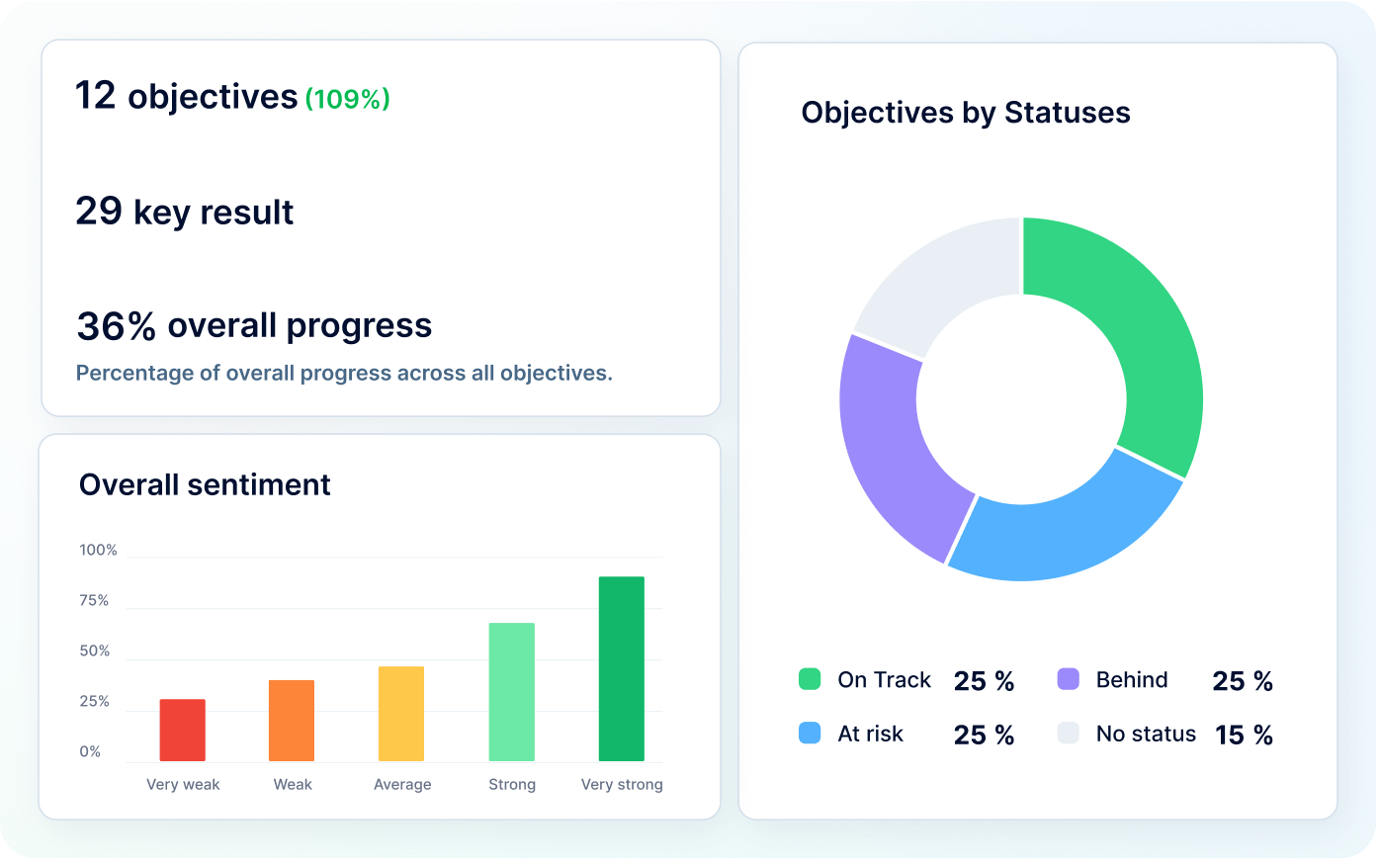
Recent articles
10 HR workflows that you should automate
Let's consider why automated workflows are necessary in 2023 and where the demand for avoiding human error in task execution comes from.
Top 25 methods of hiring pre-screening
Pre-screening is a preliminary assessment of the professionals with whom we will have to collaborate with. In this case, we are only interested in working skills/hard skills.
How HRM tools help address underperformance
Employees can be a company's greatest asset in achieving its corporate goals. Achievements depend on how the team handles its primary responsibilities

